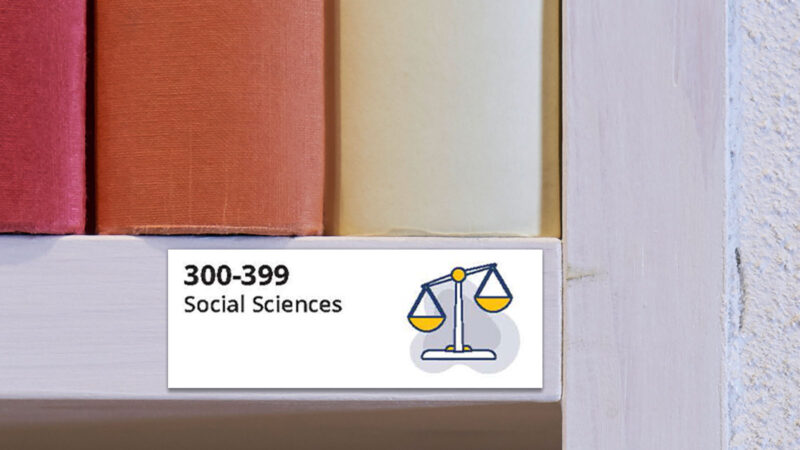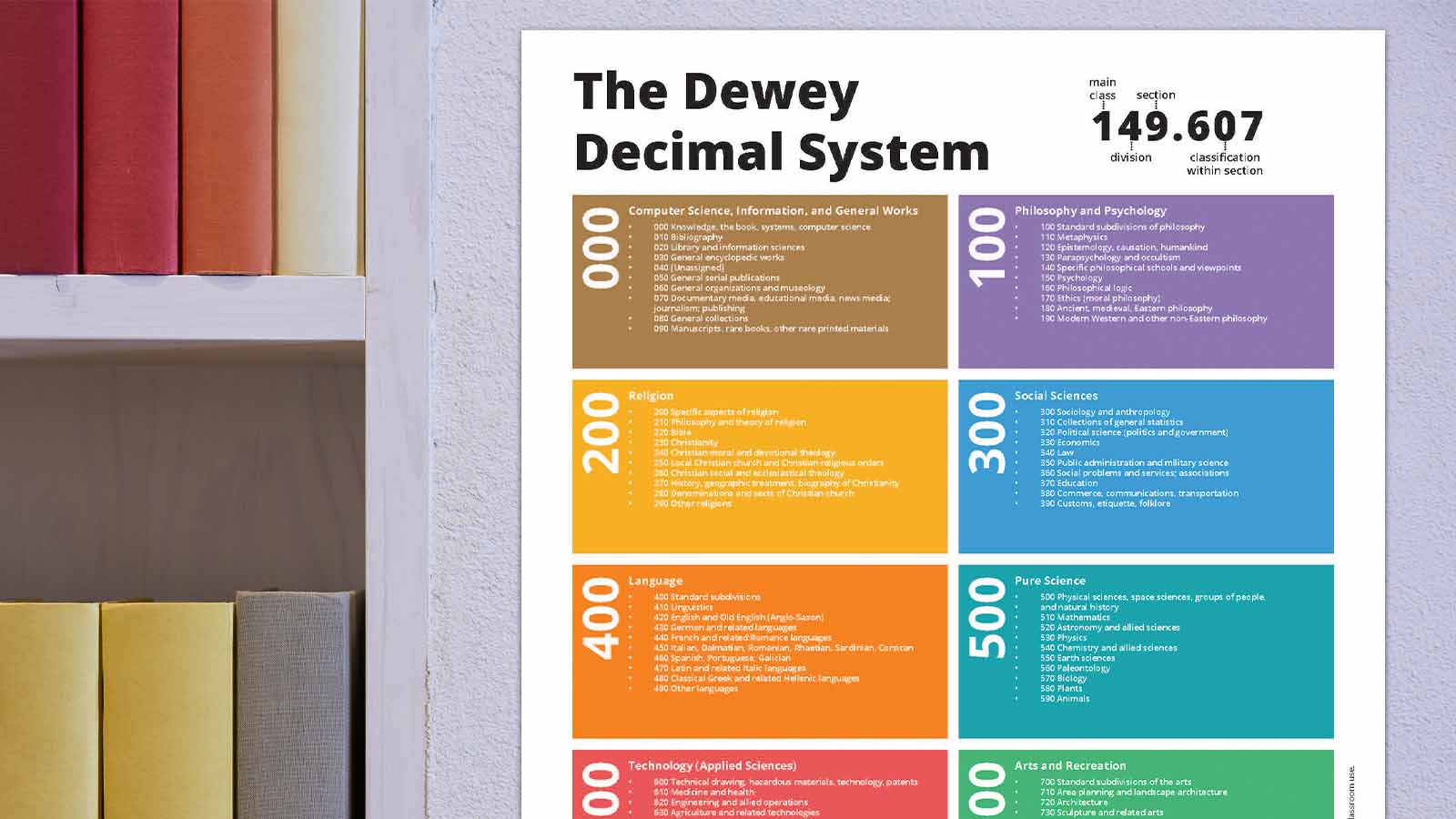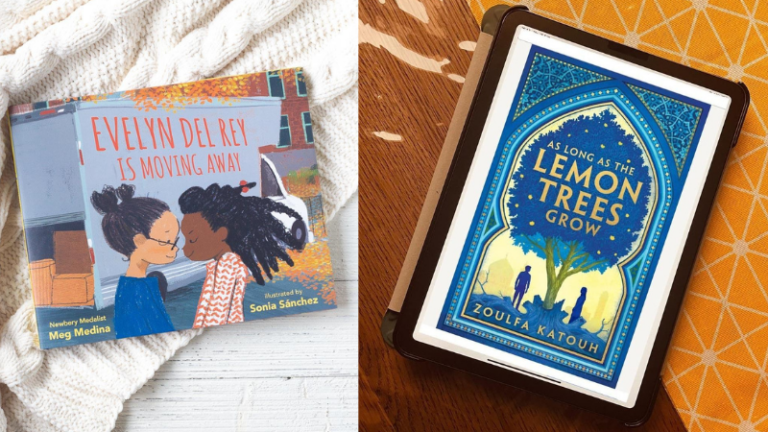Knowing how to to find the right books in the library is like a learning superpower! One of the most important library skills is understanding the Dewey Decimal System. Learn more about this library classification system below. Plus fill out the form on this page to get your free Dewey Decimal System printable chart, posters, and labels.
The bundle includes:
- 10 posters, one for each of the main classes
- 2 charts , one simple chart listing main classes and one detailed chart listing main classes and divisions
- 1 sheet of bookshelf labels, one label for each of the main classes
Jump to:
- What is the Dewey Decimal System?
- How does the Dewey Decimal System work?
- Dewey Decimal System Classes
- What’s included in the Dewey Decimal System printable bundle?
What is the Dewey Decimal System?
In libraries, fiction books can be organized in a variety of ways. Nonfiction books, though, are nearly always classified using the Dewey Decimal System. Invented in the late 1800s by Melvil Dewey, this system revolutionized the way libraries helped customers find books. Prior to Dewey’s system, libraries assigned each nonfiction book a number using their own system. Because nonfiction library stacks weren’t open to the public, only librarians needed to know how each library’s system worked.
Dewey suggested breaking books down by subject, assigning them detailed “call numbers” that showed exactly where they fit into specific categories, known as classes. This allowed patrons to find their own books more easily, using the call number assigned to each. The system has changed and expanded over time, as new subjects (such as computer science) became popular. But the overall classification system itself continues to work in the same way Dewey originally envisioned.
Learn more about Melvil Dewey here.
How does the Dewey Decimal System work?

Each book is assigned a starting number from 000 to 999, based on its overall subject matter. Within each class, further numbers help break down categories into even more specific subjects. The three-digit number before the decimal point places the book into a broad category, while numbers after the decimal point get much more specific.
To understand it, it’s easiest to look at an example. We’ll use David McCullough’s well-known biography of U.S. president John Adams. Its basic Dewey Decimal call number is 973.4. Here’s how librarians get that number:
First, they find the three-digit number that comes before the decimal point:
- 900s: History
- 970s: History of North America
- 973: United States
- 970s: History of North America
Then, they break the class down even further by using numbers after the decimal point.
- 973.4: Constitutional period, 1789–1809
Depending on the book, there may be even more numbers after the decimal point. There may also be other numbers assigned to help distinguish similarly titled books from one another. For a more complete look at the Dewey Decimal System chart and how it works, click here.
Dewey Decimal System Classes
Here’s a closer look at the general categories in the Dewey Decimal System. For more details on each, visit the OCLC’s Dewey Services page here.
And don’t forget to grab your free printable Dewey Decimal System chart to share with students!
000: Computer Science, Information, and General Works
This category consists of books that contain general knowledge (like encyclopedias). It also includes information about library sciences, journalism, and publishing, as well as rare books or manuscripts.
- 000 Knowledge, the book, systems, computer science
- 010 Bibliography
- 020 Library and information sciences
- 030 General encyclopedic works
- 040 [Unassigned]
- 050 General serial publications
- 060 General organizations and museology
- 070 Documentary media, educational media, news media; journalism; publishing
- 080 General collections
- 090 Manuscripts, rare books, other rare printed materials
Example Books:
100: Philosophy and Psychology

From metaphysics and psychology to Eastern and Western philosophy, this category is for all the thinkers out there.
- 100 Standard subdivisions of philosophy
- 110 Metaphysics
- 120 Epistemology, causation, humankind
- 130 Parapsychology and occultism
- 140 Specific philosophical schools and viewpoints
- 150 Psychology
- 160 Philosophical logic
- 170 Ethics (moral philosophy)
- 180 Ancient, medieval, Eastern philosophy
- 190 Modern Western and other non-Eastern philosophy
Example Books:
200: Religion
You’ll find all world religions in this class, though it has a heavy focus on Christianity.
- 200 Specific aspects of religion
- 210 Philosophy and theory of religion
- 220 Bible
- 230 Christianity
- 240 Christian moral and devotional theology
- 250 Local Christian church and Christian religious orders
- 260 Christian social and ecclesiastical theology
- 270 History, geographic treatment, biography of Christianity
- 280 Denominations and sects of Christian church
- 290 Other religions
Example Books:
- 248.4 The Screwtape Letters (Lewis)
- 293.13 Norse Mythology (Gaiman)
300: Social Sciences

This class is all about human society and the relationships between people. It includes subjects like sociology, law, politics, and education.
- 300 Sociology and anthropology
- 310 Collections of general statistics
- 320 Political science (politics and government)
- 330 Economics
- 340 Law
- 350 Public administration and military science
- 360 Social problems and services; associations
- 370 Education
- 380 Commerce, communications, transportation
- 390 Customs, etiquette, folklore
Book Examples:
400: Language
The books in this class cover all the languages of the world. This can include reference works like a dictionary or thesaurus, as well as books about the history and usage of languages.
- 400 Standard subdivisions
- 410 Linguistics
- 420 English and Old English (Anglo-Saxon)
- 430 German and related languages
- 440 French and related Romance languages
- 450 Italian, Dalmatian, Romanian, Rhaetian, Sardinian, Corsican
- 460 Spanish, Portuguese, Galician
- 470 Latin and related Italic languages
- 480 Classical Greek and related Hellenic languages
- 490 Other languages
Book Examples:
500: Pure Science
While the 300s cover social sciences, this class includes “pure” science fields like biology, mathematics, physics, and more. You’ll sometimes see this class called “Natural Sciences” instead.
500 Physical sciences, space sciences, groups of people, and natural history
510 Mathematics
520 Astronomy and allied sciences
530 Physics
540 Chemistry and allied sciences
550 Earth sciences
560 Paleontology
570 Biology
580 Plants
590 Animals
Book Examples:
600: Technology (Applied Sciences)
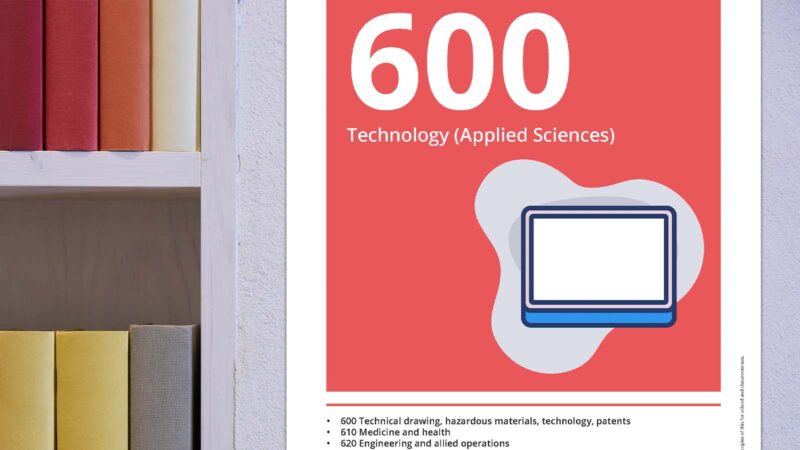
When we think of technology, we tend to think about computers or smartphones. But this class covers technology as a wider field and includes applied sciences like home economics, agriculture, and medicine.
- 600 Technical drawing, hazardous materials, technology, patents
- 610 Medicine and health
- 620 Engineering and allied operations
- 630 Agriculture and related technologies
- 640 Home and family management
- 650 Management and auxiliary services
- 660 Chemical engineering and related technologies
- 670 Manufacturing
- 680 Manufacture of products for specific uses
- 690 Construction of buildings
Book Examples:
- 616.89 Girl, Interrupted (Kaysen)
- 641.5 Kitchen Confidential: Adventures in the Culinary Underbelly (Bourdain)
700: Arts and Recreation
This class includes fine arts subjects like painting and drawing (including comics), as well as performing arts like theater and music. You’ll also find recreation-related topics like athletics and games.
- 700 Standard subdivisions of the arts
- 710 Area planning and landscape architecture
- 720 Architecture
- 730 Sculpture and related arts
- 740 Graphic arts and decorative arts
- 750 Painting and paintings
- 760 Printmaking and prints
- 770 Photography, computer art, cinematography, videography
- 780 Music
- 790 Recreational and performing arts
Book Examples:
800: Literature
Many people don’t realize that Dewey’s classification system includes a category for fiction. Most libraries don’t classify their fiction books using Dewey Decimal call numbers; they instead break them into categories like mystery, romance, etc., and alphabetize them by author’s last name. But you’ll find some forms of literature classed by their DD call number instead, such as poetry, plays, letters, and essays.
- 800 Standard subdivisions; rhetoric; collections; history, description, critical appraisal of more than two literatures
- 810 American literature in English
- 820 English and Old English (Anglo-Saxon) literatures
- 830 German literature and literatures of related languages
- 840 French literature and literatures of related Romance languages
- 850 Literatures of Italian, Dalmatian, Romanian, Rhaetian, Sardinian, Corsican languages
- 860 Literatures of Spanish, Portuguese, Galician languages
- 870 Latin literature and literatures of related Italic languages
- 880 Classical Greek literature and literatures of related Hellenic languages
- 890 Literatures of other specific languages and language families
Example Books:
- 822.23 The Complete Works of William Shakespeare
- 883.01 The Odyssey (Homer)
900: History and Geography
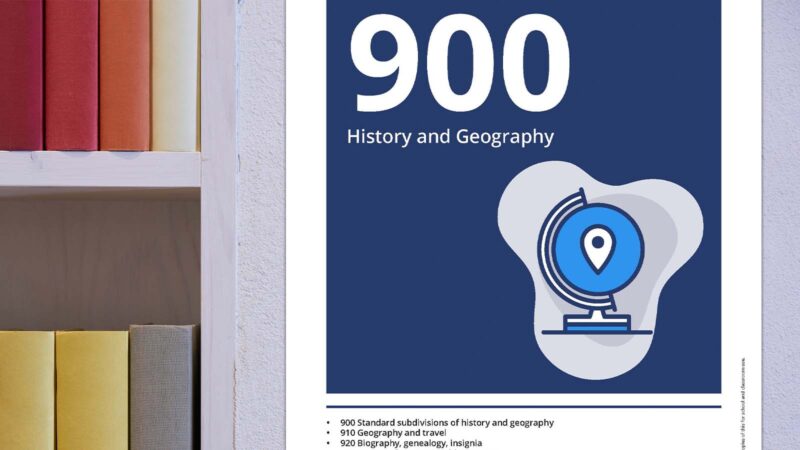
Head to this section for all things history, including biographies. This is also where you’ll find books about travel and genealogy.
- 900 Standard subdivisions of history and geography
- 910 Geography and travel
- 920 Biography, genealogy, insignia
- 930 History of ancient world to ca. 499
- 940 History of Europe
- 950 History of Asia
- 960 History of Africa
- 970 History of North America
- 980 History of South America
- 990 History of Australasia, Pacific Ocean islands, Atlantic Ocean islands, Arctic islands, Antarctica, extraterrestrial worlds
Book Examples:
- 919.404 In a Sunburned Country (Bryson)
- 973.3 1776 (McCullough)
What’s included in the Dewey Decimal System Printable Bundle?
Dewey Decimal System Simple Chart
This chart listing all of the main classes can be printed and hung on the wall as a poster or used as a handout for younger students.
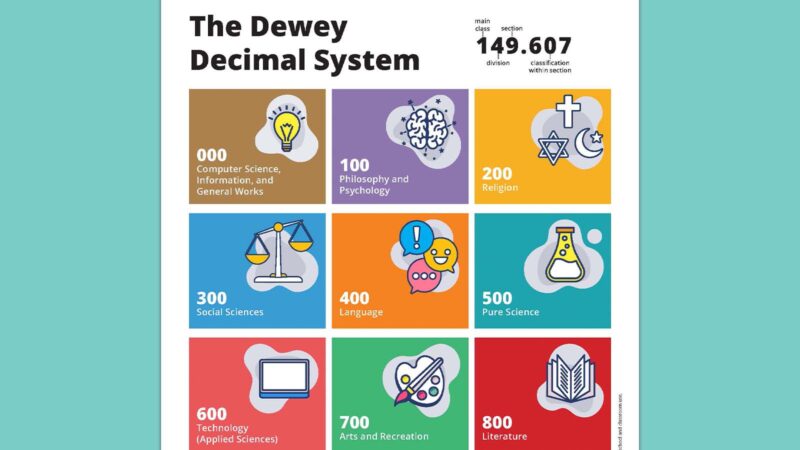
Dewey Decimal System Detailed Chart
The second chart lists the main classes along with the divisions within each class. It’s a great reference tool for older students.
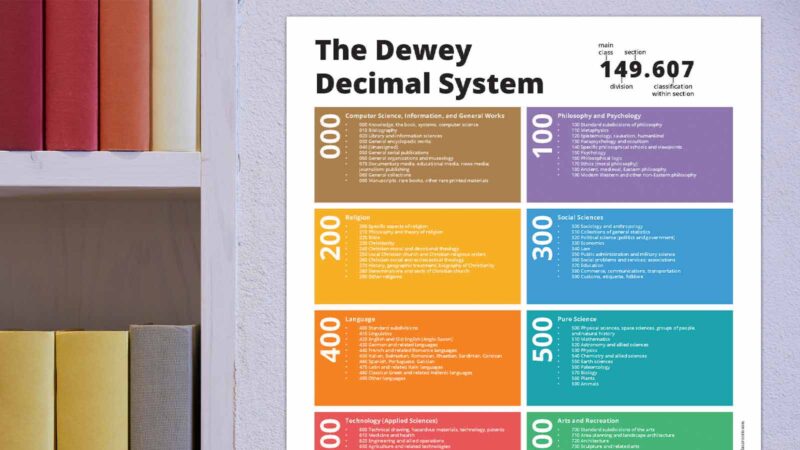
Dewey Decimal System Posters
There are also posters for each main class and list divisions within each class. These are perfect for hanging throughout the library.

Dewey Decimal System Labels for Bookshelves
Print this sheet listing each of the main classes on standard 2.625″ x 1″ address labels.
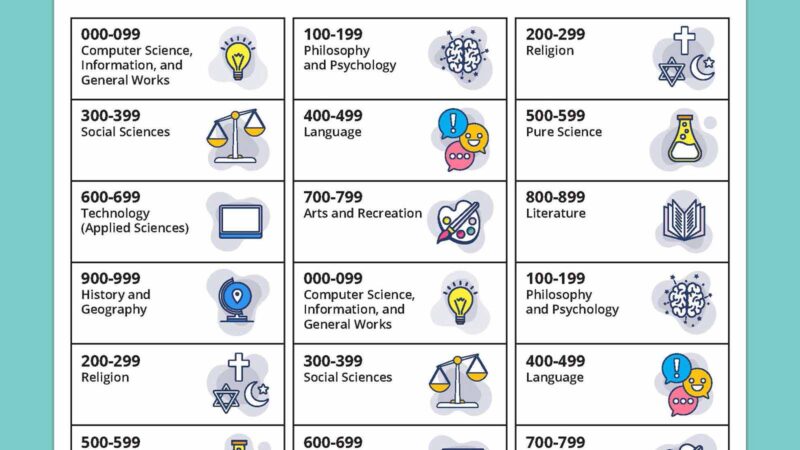
Then attach them to your bookshelves for an organized library.
